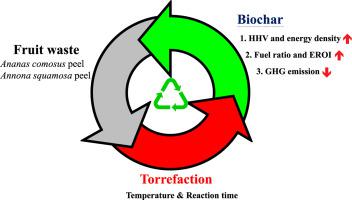Journal of Cleaner Production ( IF 9.7 ) Pub Date : 2020-10-14 , DOI: 10.1016/j.jclepro.2020.124676 Yi-Li Lin , Nai-Yun Zheng , Cheng-Hsun Hsu

|
This study torrefied Ananas comosus peel (ACp) and Annona squamosa peel (ASp) samples at different temperatures (210–300 °C) for different durations (30 and 60 min) to produce biochar as a renewable energy source. Analysis results indicated that the torrefaction temperature, not the reaction duration, had a dominant influence on the characteristics of the produced biochar. The ACp biochar had a maximum higher heating value (HHV) of 27.7 MJ/kg and maximum energy density of 1.58, which were higher than those of the ASp biochar. As the torrefaction temperature and time increased, the fixed carbon and ash contents and the fuel ratio (FR) increased gradually for both types of biochar, but the volatile matter content and energy return on investment (EROI) decreased. The hydrogen/carbon and oxygen/carbon atomic ratios of both types of biochar are comparable to those reported for lignite. Thermogravimetric and derivative thermogravimetric analyses confirmed that the thermal stability of both types of fruit waste increased considerably with the torrefaction temperature. Furthermore, the ACp biochar had a maximum EROI of 22.9 and FR of 0.36. When 10%–20% biochar was cofired with 80%–90% bituminous coal in a power plant, the FR (1.80–1.84 and 1.60–1.67)—representing combustion efficiency—approximated that of bituminous coal (1.5–2.5), but greenhouse gas (GHG) emissions decreased significantly (83.7%–94.3%). Taken together, the cofiring of ACp biochar or Asp with coal is potentially viable and economically beneficial for increasing the HHV, energy density, fixed carbon content, FR, and EROI of these materials while reducing GHG emissions, rendering these materials suitable for partially replacing bituminous coal in power plants.
中文翻译:

果皮废料的焙干生产环保型生物燃料
这项研究烘焙菠萝皮(ACP)和番荔枝在不同温度(210–300°C)下剥离样品(ASp),持续时间(30分钟和60分钟),以产生生物炭作为可再生能源。分析结果表明,焙干温度而不是反应持续时间对生产的生物炭的特性具有主要影响。ACp生物炭的最高发热量(HHV)为27.7 MJ / kg,最大能量密度为1.58,高于ASp生物炭的热值。随着焙烧温度和时间的增加,两种类型的生物炭的固定碳和灰分含量以及燃料比(FR)逐渐增加,但是挥发性物质含量和能量投资回报率(EROI)下降。两种类型的生物炭的氢/碳和氧/碳原子比与报道的褐煤相当。热重和衍生热重分析证实,两种类型的水果废料的热稳定性都随着焙干温度的增加而大大提高。此外,ACp生物炭的最大EROI为22.9,FR为0.36。当某发电厂将10%–20%的生物炭与80%–90%的烟煤共燃时,FR(1.80–1.84和1.60–1.67)(代表燃烧效率)近似于烟煤的燃烧效率(1.5–2.5),但是温室气体(GHG)排放量显着下降(83.7%–94.3%)。综上所述,将ACp生物炭或Asp与煤共烧具有可行性,并在经济上有利于增加这些材料的HHV,能量密度,固定碳含量,FR和EROI,同时减少温室气体排放,使这些材料适合部分替代沥青。电厂中的煤炭。











































 京公网安备 11010802027423号
京公网安备 11010802027423号